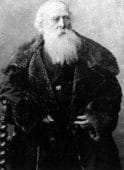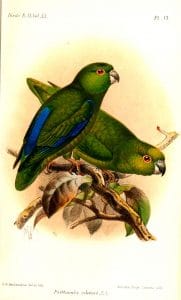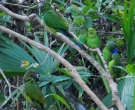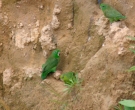Content |
|---|
Description:
13 cm.. length and 28 g. of weight.
Chubby appearance, the Dusky-billed Parrotlet (Forpus modestus) has the forecrown, lores, cheeks and crown, emerald green, forming sometimes a visible mask; the sides and rear of the neck, the the mantle, the upper part of the back and scapulars, rather dark, of color green matte with light color of olive; lower back and rump of color blue cobalt dark: uppertail-coverts dark green. Primaries and larger covers, dark blue. Primaries with innerwebs green; Secondary of color blue dark with tips Green. Under the wings of color blue cobalt dark; flight feather grey-blue. Underparts opaque in color green dark with a light shade of olive. Upper, the tail dark green; undertail, paler.
upper jaw and cere dark gray, lower jaw clearer; Strait ring perioptalmico dark gray; Iris dark brown; legs grey.
Female all green except beige in it forecrown and front of the crown, contrasting with the Green more dark on the back of the crown.
Immature as their respective adult but paler.
- Sound of the Dusky-billed Parrotlet.
Subspecies description:
-
Forpus modestus modestus
(Cabanis, 1849) – The nominal.
-
Forpus modestus sclateri
(Gray,GR, 1859) – Similar to the nominal species but from a color green more pale, more yellowish below, male with blue pale in rump and wings ; the face Green Emerald bright.
Habitat:
They inhabit in tropical forest lowlands in clear, margins, coastal growth, forests and marshes, secondary habitats and sheets, mainly in lowlands (150-250 metres in Venezuela, to 500 metres in Colombia), but spreading in sub-tropical forests to 1,500-1, 800 m in the Eastern Andes of Ecuador.
Gregarious; Outside the breeding season, sometimes in flocks of 100 or more individuals
Reproduction:
It nests in hollows and dead trees. breeding season of registered in the month of July in Peru.
Food:
The diet comprises seeds (for example, Cecropia miparia), berries, egg yolks, etc. It takes the banks along with other parrots mineral soil.
Distribution:
Size distribution (reproduction / resident): 2.840.000 km2
Discontinuous distribution. Since the Guianas to the North of Bolivia. Although according to reports in Guyana and French Guiana not there are records (at least not recently). Be distributed by the Basin Amazon East of Brazil in Amapá, Maranhão and For, and in the Basin Amazon West from the high of the Black river to the North of Mato Grosso; in Venezuela, to the South of the Orinoco, on bass Caura River and Cuyuni River (a record of Carabobo; in the North, is apparently wrong); In East Colombia to the South from the East end of the Guainia (about him Black river) until Caquetá to the East of Ecuador and East of Peru to the South and to the North of Bolivia at least Beni.
Reasonably frequent in the West of its range (the Forpus most common in the range in Ecuador and Colombia) but scarcer eastward, with few records in Venezuela and Guyanas.
Evidence of decline in the Eastern Amazonia (about Bethlehem) and possible increase in Colombia, perhaps linked to reduction of dense forests.
Rare in captivity.
Subspecies distribution:
-
Forpus modestus modestus
(Cabanis, 1849) – The nominal.
-
Forpus modestus sclateri
(Gray,GR, 1859) – Southeast of Colombia to the North of Bolivia and Brazilian Amazon.
Conservation:
State of conservation ⓘ |
||
|---|---|---|
 Minor Concern ⓘ
(UICN)ⓘ
Minor Concern ⓘ
(UICN)ⓘ
| ||
• Red List Category: Least concern
• Population trend: Stable
Justification of the population:
The size of the world population Dusky-billed Parrotlet It has not been quantified, but this species is described as “quite common” (Stotz et to the., 1996).
Justification of trend:
It is suspected that this species has lost 11,6-12,6% of habitat within its distribution in three generations (12 years) based on a model of Amazon deforestation (Soares-Filho et to the., 2006, Bird et to the., 2011).
Given the susceptibility of the species to hunt or capture, It is suspected that it will fall in <25% durante tres generaciones.
"Dusky-billed Parrotlet" in captivity:
In captive not all known, However, this species is probably similar to other parakeet species – quite quiet, best with a partner, although, they can be aggressive with other groups of parrots. It has a tendency to obesity.
You can learn to speak, usually up to around. 15 words. Males are generally more loquacious than females. They can also learn to whistle numerous tunes and perform some tricks..
This Parrot is very small, they do not occupy much space, It makes it an ideal pet for people living in apartments, residences, or anywhere else than in small size, do not require a large cage and its maintenance is simple.
Alternative names:
– Dusky-billed Parrotlet, Dusky billed Parrotlet, Sclater’s Parrotlet (English).
– Toui de Sclater (French).
– Schwarzschnabel-Sperlingspapagei (German).
– tuim-de-bico-escuro (Portuguese).
– Catita Enana Oscura, Cotorrita de Sclater, Periquito Piquinegro (español).
– Periquito Piquinegro (Colombia).
– Periquito de Pico Oscuro (Peru).
– Periquito Pico Oscuro (Venezuela).
scientific classification:

– Order: Psittaciformes
– Family: Psittacidae
– Genus: Forpus
– Scientific name: Forpus modestus
– Citation: (Cabanis, 1849)
– Protonimo: Psittacula Sclateri
Images Dusky-billed Parrotlet:
Videos of the "Dusky-billed Parrotlet"
Dusky-billed Parrotlet (Forpus modestus)
Sources:
– Avibase
– Parrots of the World – Forshaw Joseph M
– Parrots A Guide to the Parrots of the World – Tony Juniper & Mike Parr
– Birdlife
– Photos:
(1) – Brazil – Crystal River (Amazonia)
(2) – Periquito de pico oscuro en Alta Floresta – MT – Brasil By Hector Bottai (Own work) [CC BY-SA 3.0], via Wikimedia Commons
(3) – Periquito de pico oscuro en Alta Floresta – MT – Brasil By Hector Bottai (Own work) [CC BY-SA 3.0], via Wikimedia Commons
(4) – Forpus modestus by Gunther Eichhorn – Flickr
(5) – Dusky Billed Parrotlets at the end of the branch with Dusky Headed Parrots by Vince Smith – Flickr
(6) – Psittacula sclateri = Forpus modestus, Dusky-billed Parrotlet by John Gerrard Keulemans [Public domain], via Wikimedia Commons
– Sounds: (Xeno-canto)






